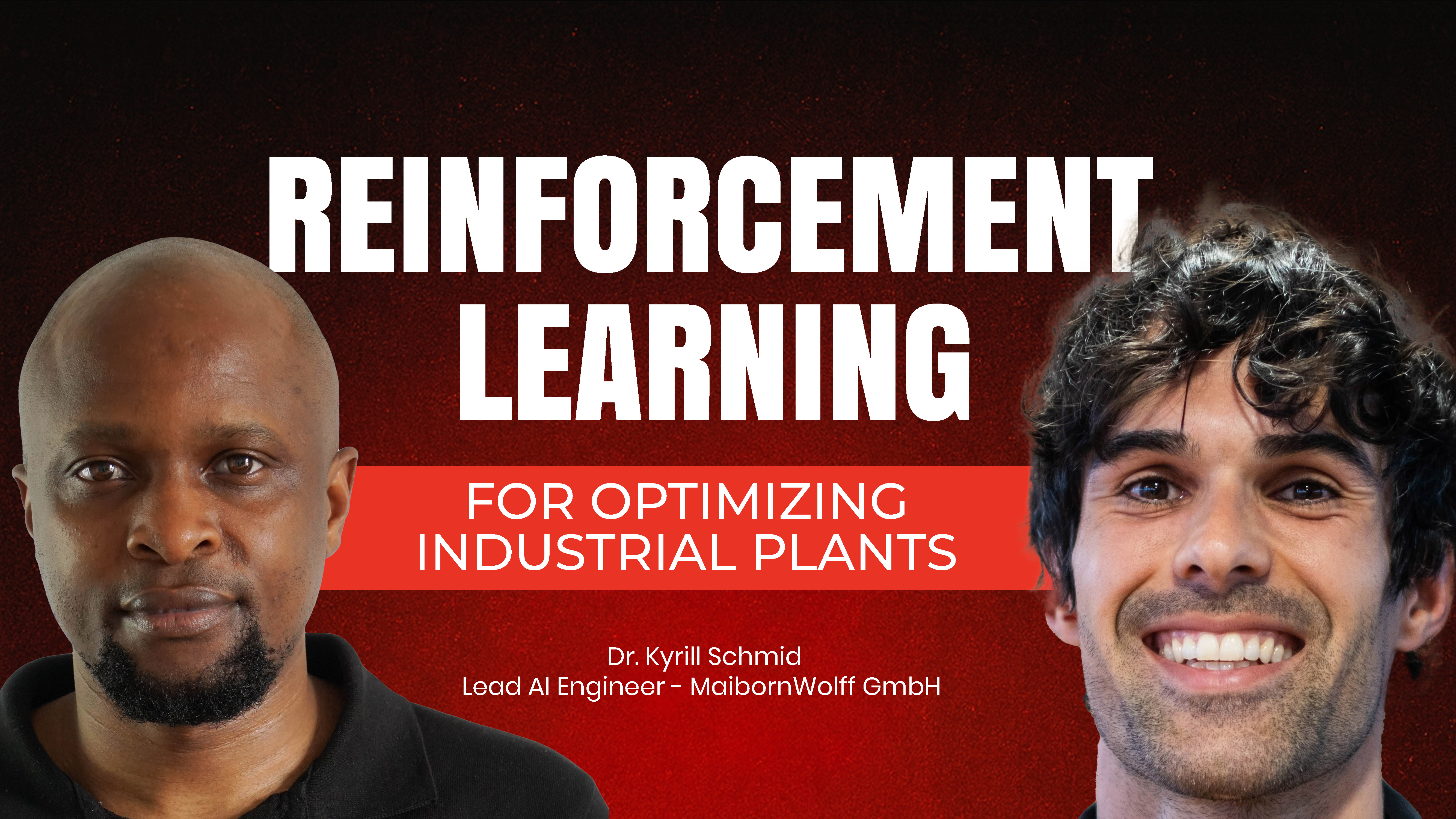November 2, 2025

Many companies have invested millions building predictive models that forecast energy consumption, classify defects, and flag maintenance needs. They work well for what they do. But they all share the same fundamental limitation: they can only tell you what will happen, not what you should do about it.
That's where reinforcement learning changes the game. It solves optimization problems that traditional machine learning can't touch, finding completely new strategies that humans never considered, adapting to changing conditions in real-time, and discovering solutions in spaces too complex for hard-coded control logic.
Kiril Schmidt, Lead AI Engineer at Maibornwolff with a decade of experience applying reinforcement learning to industrial problems, explains why this technology represents manufacturing's next evolution, and what it takes to actually make it work.
What Reinforcement Learning Actually Does (And Why It Matters)
Most data leaders think about industrial AI as either predictive analytics or large language models. Reinforcement learning is neither. It's a fundamentally different approach that's been around since the 1990s but is only now becoming practical for manufacturing at scale.
Here's the core difference: reinforcement learning is goal-oriented, not pattern-matching. You don't train these models on historical data to predict outcomes. Instead, you give them an objective and let them figure out the optimal strategy through trial and error.
Think of it this way:
- Traditional ML: "Based on past data, here's what will probably happen next"
- LLM-based agents: "Based on my training, here's information and recommendations"
- Reinforcement learning agents: "Let me try different actions and learn which sequence of decisions best achieves the goal"
The breakthrough example that proved this approach was AlphaGo, which learned to play the ancient board game Go. After training, it didn't just match human experts, it discovered completely new strategies that human players had never seen in thousands of years of playing the game. The world champion lost 100 straight games to it.
This matters for manufacturing because your plants face similar challenges: enormously complex state spaces, countless variables interacting in non-linear ways, and optimal solutions that aren't obvious even to your most experienced engineers.
When to Use Reinforcement Learning vs. Your Current Approach
Not every problem needs reinforcement learning. Your existing predictive models and control systems work well for specific tasks. Understanding when to reach for each tool is critical for data leaders making infrastructure investments.
Stick with traditional predictive AI for:
- Narrow analytical problems with clear inputs and outputs
- Forecasting specific numbers (tomorrow's energy consumption, next quarter's yield)
- Classification tasks (defect detection, quality states, equipment conditions)
- Situations where you have good historical labeled data
- Problems where you need to support human decision-making with information
Consider reinforcement learning for:
- High-dimensional optimization problems where hundreds of variables interact. Traditional control systems struggle when you need to consider 50+ parameters simultaneously.
- Dynamic environments that change over time. Your hard-coded control logic from 20 years ago can't adapt to new equipment, different suppliers, or shifting operating conditions. A continuously learning agent can.
- Long-term optimization goals that require sequences of decisions. Energy efficiency often involves trade-offs across multiple time horizons that are impossible to code manually.
- Discovering unknown optimal strategies. When your team suspects better approaches exist but can't identify them through traditional process engineering, RL agents can explore the solution space systematically.
The key insight: reinforcement learning complements rather than replaces traditional control. Think of it as an additional optimization layer on top of your existing systems, not a rip-and-replace project.
The Infrastructure Reality Check
Before you can deploy reinforcement learning, you need three foundational layers in place. Most manufacturing data leaders underestimate these requirements.
Layer 1: Data generation and access
Reinforcement learning is incredibly data-hungry, but the data requirements differ from traditional ML. You have two paths:
- Online learning: The agent interacts with a simulation or live system, learning as it goes. This requires either a high-fidelity digital twin or the ability to safely explore in production (rare in manufacturing).
- Offline learning: Train on historical data from your historians and SCADA systems. The challenge here is you need broadly distributed data across your entire state-action space, not just narrow operational windows. If your historical data only covers normal operations, the agent can't learn how to handle edge cases.
Layer 2: Connectivity and protocols
Training deep reinforcement learning agents requires massive compute, specifically GPUs or TPUs with thousands of cores for parallel tensor operations. You need robust data pipelines to move operational data from OT systems to your training environment. Protocols like MQTT and UNS (Unified Namespace) help bridge this gap, but many manufacturing sites still lack this infrastructure.
Layer 3: Compute resources
A single training run might simulate years of operation in hours or days, but only if you have the compute capacity. This typically means cloud GPU clusters or on-premise infrastructure specifically designed for deep learning workloads. Budget accordingly.
The sobering reality: data infrastructure is usually the first blocker. Many manufacturers have been collecting data for years but lack the engineering to make it accessible for advanced ML applications.
The Trust Problem, And How to Solve It
Deep neural networks are black boxes. In manufacturing, that's a problem. When an RL agent recommends changing your process parameters, operators and managers rightfully ask: "Why? How do we know this won't cause a catastrophic failure?"
You can't afford to wave your hands and say "the AI knows best." You need multiple strategies to build trust:
Explainability techniques:
- Visual highlighting showing which input features drove specific decisions
- Sensitivity analysis revealing how the agent responds to different conditions
- Policy visualization that maps out the agent's decision-making strategy
Reliability and performance monitoring:
- Frequent evaluation against specific KPIs so stakeholders can see consistent performance
- Continuous tracking of how the agent behaves in different scenarios
- Clear metrics showing improvement over baseline
Human-in-the-loop approaches:
During training, you can use imitation learning, having expert operators guide the agent toward better states, dramatically speeding up learning. Think of a robot trying to learn backflips: random exploration would take forever, but a human demonstrating the motion provides a starting point.
During deployment, always maintain the ability for human intervention. The agent should be able to escalate situations it hasn't been trained for, similar to how an airplane's autopilot disengages and hands control back to the pilot when conditions exceed its parameters.
Scaling Across Your Enterprise, The Hard Parts
You've successfully trained an RL agent to optimize one chiller at one site. Now you need to scale it across 50 sites with hundreds of pieces of equipment. This is where most organizations struggle.
The core tension: agents trained for specific equipment and conditions don't automatically generalize to different environments. Your options:
Train separate models for each context
- Pros: Maximum performance for each specific situation
- Cons: Expensive, time-consuming, requires data from every location
Transfer learning approach
- Train a large base model on diverse data across your enterprise
- Fine-tune specialized versions for specific sites or equipment types
- Similar to how LLMs work: broad foundation model, then customization
- Requires centralized data infrastructure and serious compute resources
Hybrid approaches
- Start with equipment that's similar enough to share models
- Gradually expand as you gather more data and training capacity
- Accept that full enterprise coverage will take years, not months
The non-technical challenges matter just as much. Scaling AI across manufacturing requires organizational change management. Different sites have different cultures, risk tolerances, and operational practices. Technology rollout is the easy part compared to getting buy-in from dozens of site managers and hundreds of operators.
Conclusion
Reinforcement learning won't replace your predictive models or control systems. But for complex optimization problems, energy efficiency, process control, production scheduling, it can find solutions your current approaches can't.
The technology is maturing. What was computationally impractical five years ago is now feasible. LLM infrastructure investments are forcing companies to build the data pipelines and compute capacity that also enable reinforcement learning.
But be realistic about what it takes: substantial data infrastructure, specialized expertise, significant compute resources, and a multi-year commitment to scale. This isn't a quick win technology. It's a strategic capability that delivers compounding returns as you build experience and infrastructure.
The manufacturers who start building this capability now—even with small pilots on narrow problems—will have a significant advantage as the technology becomes more accessible. Your competitors are probably already experimenting. The question is whether you'll lead or follow.
Kudzai Manditereza is an Industry4.0 technology evangelist and creator of Industry40.tv, an independent media and education platform focused on industrial data and AI for smart manufacturing. He specializes in Industrial AI, IIoT, Unified Namespace, Digital Twins, and Industrial DataOps, helping digital manufacturing leaders implement and scale AI initiatives.
Kudzai hosts the AI in Manufacturing podcast and writes the Smart Factory Playbook newsletter, where he shares practical guidance on building the data backbone that makes industrial AI work in real-world manufacturing environments. He currently serves as Senior Industry Solutions Advocate at HiveMQ.



